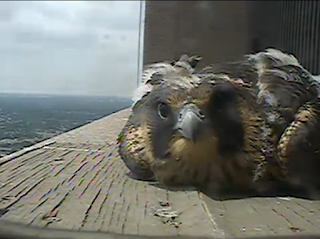Here's a picture from late last week "before" the camera housing got doused with excrement: A nice shot of a feeding showing how the chicks are growing. It is even hard to tell which one was the last hatched now!
And a photo "after" - there is now a blurry haze we have to look though since the nestlings have defecated further on the front of the camera housing. But, at least for now the obstruction is somewhat uniform and the entire view is not blocked.
The chicks will be 3 weeks old this week. Three weeks old is when we typically have banded the chicks in past years. During the banding we usually take the opportunity to clean the front of the camera housing since we are out on the ledge anyway. This year the chicks will not be banded but we will use the same window of time to go out on to the ledge to clean the camera front before they get much older.
Why no banding?
As was announced last year, 2015 was the final year for banding of peregrine falcon
chicks in Ohio. The background for the decision
is based on the status of the population.
The peregrine population has recovered to the point that they are no
longer an endangered species. The main
goal of banding any species is done for research purposes—to help track
migrations, longevity and productivity, etc.
This information is very helpful when a species is in peril to identify
areas of weaknesses that maybe can be addressed through conservation
efforts. When the population of a species is
stable then there is less of a need for that type of information. And, while we do our best to make the banding
process as safe as possible, there is always still a risk whenever we have
our hands on a wild animal that something may go wrong. Finally,
there is staff time involved in the banding process which adds costs to the project. All that being said and all factors taken
into consideration, it was decided that the return/benefit of banding the
chicks in Ohio was no longer justified in continuing the effort. This long explanation is more easily summed up by simply stating it is actually good
news that the peregrine population is doing so well that we do not need to
micro manage them (including banding) as in the past.
The discontinuation of banding and the positive upturn of
the population and the fact that peregrines are no longer a listed (endangered
or threatened) species does not mean that they are aren’t going to be protected
or monitored. They will have continued
State and Federal protection under the Migratory Bird Treaty Act and we will
continue to monitor their productivity and status, just less intensively as
we’ve done the past 20+ years. Continued
monitoring and protections will ensure that, if the population were to begin to
decline again for whatever reason, it would be noticed sooner than later and
conservation efforts could be enacted to reverse that trend, if/when needed.
Aside from the biology, looking at the Education and
Awareness aspects of the project, no longer banding may detract some from the
project for some viewers. Part of the
allure of watching the species via cameras is the identification of individuals
through leg bands and knowing how old they are and where they were hatched
from. Over time, as fewer and fewer peregrines are banded (not only in Ohio but in other states as well) we will
begin to see more individuals show up at territories that can’t be identified
because they will not have a leg band code.
This happens occasionally now but will become more common and it is
possible that some viewers may lose interest because they can’t identify with
an individual bird. Hopefully, this will
be minimal as just the chance to watch the nesting events unfold live is still
a unique and enthralling opportunity.
We have been back and forth with continuing to involve
school children in the naming process without banding. The way that we have named the falcons at the Columbus nest has been a very powerful and worthwhile educational tool. By involving an entire school in the naming
contest, all of the students learn about wildlife conservation and they in turn
go home and educate their parents, grandparents, neighbors, etc.
etc. It has worked out extremely well in the past to
have the winning kids attend the banding of “their” falcon as part of the prize
of submitting a winning name.
Unfortunately, without banding and being able to identify individuals as
they develop in the nest and fledge, the act of naming will be lost. We will discontinue the naming contest but
attempt to work with schools in other ways to continue our educational
efforts.
So while there are some changes to be expected as the project evolves into the future, we hope that everyone can maintain that the reasons behind the changes are actually very positive for the species as a whole.














